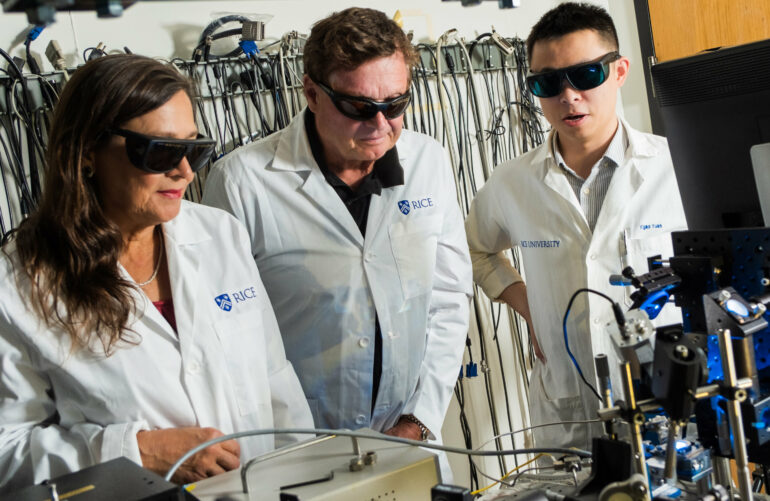As a clean-burning, potent and versatile energy commodity, hydrogen could play a key role in the transition to a sustainable energy ecosystem. However, the chemical process responsible for more than half of the current global hydrogen production is a substantial source of greenhouse gas emissions.
Rice University researchers have developed a catalyst that could render steam methane reforming (SMR) entirely emissions-free by using light rather than heat to drive the reaction. Moreover, the research could prove instrumental for extending catalyst lifetimes in general, improving efficiencies and reducing costs for a number of industrial processes plagued by coking, a form of carbon buildup that can deactivate catalysts.
The new copper-rhodium photocatalyst sports an antenna-reactor design that—when exposed to a specific wavelength of light—breaks down methane and water vapor without external heating into hydrogen and carbon monoxide, a valuable chemical industry feedstock that is not a greenhouse gas.
“This is one of our most impactful findings so far, because it offers an improved alternative to what is arguably the most important chemical reaction for modern society,” said Peter Nordlander, Rice’s Wiess Chair and Professor of Physics and Astronomy and professor of electrical and computer engineering and materials science and nanoengineering. “We developed a completely new, much more sustainable way of doing SMR.”
Nordlander and Naomi Halas, Rice University Professor and the Stanley C. Moore Professor of Electrical and Computer Engineering, are the corresponding authors on a study about the research published in Nature Catalysis.
The new SMR reaction pathway leverages the 2011 discovery from the Halas and Nordlander labs at Rice that plasmons—collective oscillations of electrons that occur when metal nanoparticles are exposed to light—can emit “hot carriers” or high-energy electrons and holes that can be used to drive chemical reactions.
“We do plasmonic photochemistry—the plasmon is really our key here—because plasmons are really efficient light absorbers, and they can generate very energetic carriers that can do the chemistry we need them to much more efficiently than conventional thermocatalysis,” said Yigao Yuan, a Rice doctoral student who is a first author on the study.
The new catalyst system uses copper nanoparticles as its energy-harvesting antennae. However, since the copper nanoparticles’ plasmonic surface does not bond well with methane, rhodium atoms and clusters were sprinkled in as reactor sites. The rhodium specks bind water and methane molecules to the plasmonic surface, tapping the energy of hot carriers to fuel the SMR reaction.
“We tested many catalyst systems, but this one turned out to work best,” Yuan said.
The research also shows that the antenna-reactor technology can overcome catalyst deactivation due to oxidation and coking by employing hot carriers to remove oxygen species and carbon deposits, effectively regenerating the catalyst with light. Nordlander said the key to this “remarkable effect was the clever placement of the rhodium,” which is spread sparingly and unevenly across the surface of the nanoparticles.
For the most part, hydrogen is currently produced in large, centralized facilities, requiring the gas to be transported to its point of use. In contrast, light-driven SMR allows for on-demand hydrogen generation, a key benefit for use in mobility-related applications such as hydrogen fueling stations or even vehicles.
“This research showcases the potential for innovative photochemistry to reshape critical industrial processes, moving us closer to an environmentally sustainable energy future,” Halas said.
More information:
Yigao Yuan et al, Steam methane reforming using a regenerable antenna–reactor plasmonic photocatalyst, Nature Catalysis (2024). DOI: 10.1038/s41929-024-01248-8
Citation:
Discovery taps ‘hot carriers’ for on-demand, emissions-free hydrogen and catalyst regeneration (2024, November 11)



